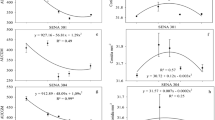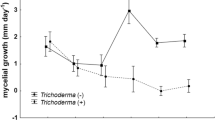Abstract
Factors known to inhibit sporulation of bio trophic fungal pathogens were found to enhance sporulation of two necrotrophic fungi. The sporulating potential ofStemphyliurn botryosum f. sp.lycopersici on tomatoes and ofAlternaria porri f. sp.solani on potatoes increased with necrotization, reaching a maximum on dead leaves. Wetting the dead leaves for the whole period of incubation with increasing concentrations of glucose resulted in progressively decreasing sporulation of both pathogens. However, application of glucose during the first half of the incubation period inhibited sporulation ofS. botryosum f. sp.lycopersici on tomatoes only a little, and increased that ofA. porri f. sp.solani on potatoes. The capacity ofS. botryosum f. sp.lycopersici to sporulate on leaves lasted for 12 weeks at 29°C, and ofA. porri f. sp.solani for 12 weeks at 29°C and for over 21 weeks at 20°C. The results emphasized basic differences in sporulation between biotrophic and necrotrophic parasites. Specific techniques useful for studying sporulationin vivo are discussed.
Similar content being viewed by others
References
Bashi, Esther (1974) Infection and Sporulation ofStemphylium botryosum f. sp.lycopersici on Tomatoes and Comparisons with other Pathogen-Suscept Systems. Ph.D. Thesis, Bar Ilan University, Ramat Gan, Israel. (Hebrew, with English summary)
Bashi, Esther andRotem, J. (1975) Effect of light on sporulation ofAlternaria porri f. sp.solani andStemphylium botryosum f. sp.lycopersici in vivo. Phytoparasitica 3(1): 63–67
Cochrane, V.W. (1958) Physiology of Fungi. J. Wiley & Sons Inc., N.Y.
Cohen, Y. andRotem, J. (1969) The effect of lesion development, air temperature andduration of moist periods on sporulation ofPseudoperonospora cubensis in cucumbers.Israel J. Bot. 18: 135–140.
Cohen, Y. andRotem, J. (1970) The relationship of sporulation to photosynthesis in some obligatory and facultative parasites.Phytopathology 60: 1600–1604.
Hawker, Lilian E. (1966) Environmental influences on reproduction, in: The Fungi, Vol. 2, pp. 435–469.G.C. Ainsworth andA.S. Sussman, Eds. Academic Press, N.Y.
Klebs, G. (1900) Zur physiologie der Fortpflanzung einiger Pilze.III Jahrb. Wiss. Bot. 32: 80–203. (After F.K. Sparrow Jr. 1960. Aquatic Phycomycetes. Univ. of Michigan Press, Ann Arbor, Mich.)
McMeekin, Dorothy (1960) The role of oospores ofPeronospora parasitica in downy mildew of crucifers.Phytopathology 70: 93–97.
Netzer, D. andKenneth, R.G. (1969) Persistence and transmission ofAlternaria dauci (Kühn) Groves & Skolko in the semi-arid conditions of Israel.Ann. appl. Biol. 63: 289–294.
Perl, M., Cohen, Y. andRotem, J. (1972) The effects of humidity during darkness on the transfer of assimilates from cucumber leaves to sporangia ofPseudoperonospora cubensis. Physiol. Pl. Pathol. 2: 113–122.
Reuveni, R., Cohen, Y. andRotem, J. (1971) Sporulation ofErysiphe cichoracearum as influenced by conditions favoring photosynthesis in the host.Israel J. Bot. 20: 78–83.
Reuveni, R. andRotem, J. (1974) Effect of humidity on epidemiological patterns of the powdery mildew(Sphaerotheca fuliginea) on squash.Phytoparasitica 2: 25–33.
Rotem, J. (1964) The effect of weather on dispersalof Alternaria spores in a semi-arid region of Israel.Phytopathology 54: 628–639.
Rotem, J. (1968) Thermo-xerophytic properties ofAlternaria porri f. sp.solani. Phytopathology 58: 1284–1287.
Rotem, J. andBashi, Esther. (1969) Induction of sporulation ofAlternaria porri f. sp.solani by inhibition of its vegetative development.Trans. Br. my col. Soc. 53: 433–439.
Schein, R.D. (1964) Design, performance, and use of a quantitative inoculator.Phyto-pathology 54: 509–513.
Silverman, W. (1960) The development of stem rust on wheat leaves treated with some sugars and sugar alcohols.Phytopathology 50: 114–119.
Skoropad, W.P. (1966) Sporulating potential ofRhynchosporium secalis on naturally infected leaves of barley.Can. J. Pl. Sci. 46: 243–247.
Waggoner, P.E. andHorsfall, J.G. (1969) Epidem, a simulator of plant disease written for a computer.Bull. Conn, agric. Exp. Stn 698.
Waters, C.W. (1928) The control of teliospore and urediniospore formation by experimental methods.Phytopathology 18: 157–213.
Wu, Y.S. (1952) Production of stem-rust on albino barley.Phytopathology 42: 177–178.
Author information
Authors and Affiliations
Rights and permissions
About this article
Cite this article
Bashi, E., Rotem, J. Host and biotic factors affecting sporulation ofstemphylium botryosum f. sp. lycopersici on tomatoes and ofalternaria porri f. sp. sol ani on potatoes. Phytoparasitica 3, 27–38 (1975). https://doi.org/10.1007/BF02981218
Received:
Accepted:
Issue Date:
DOI: https://doi.org/10.1007/BF02981218




